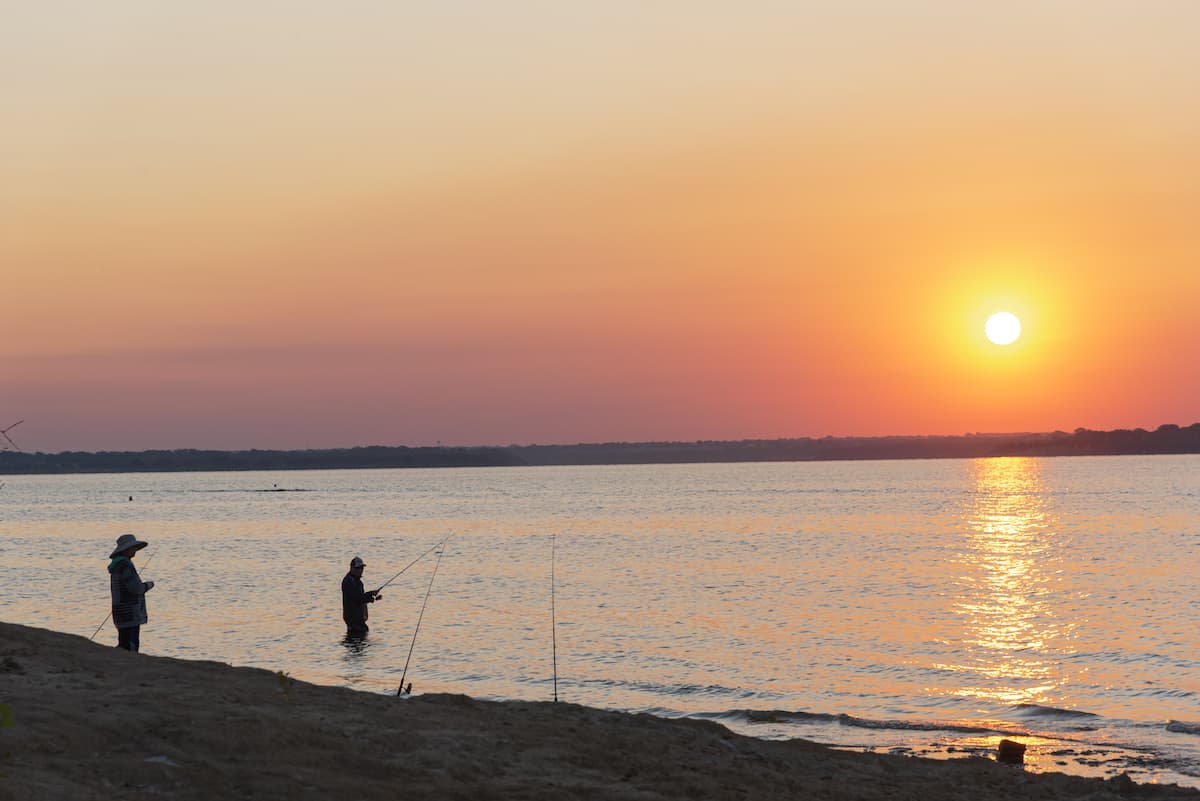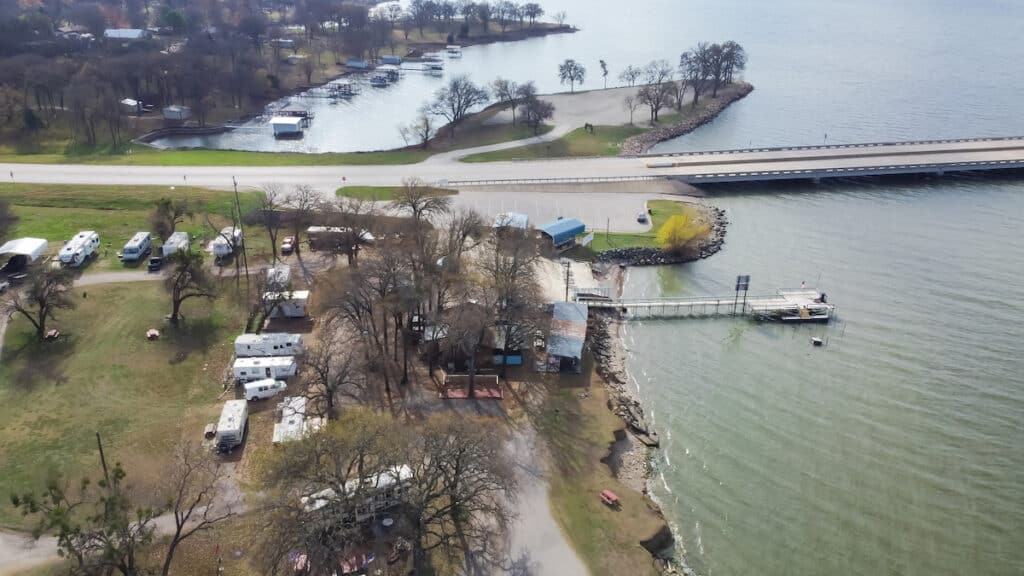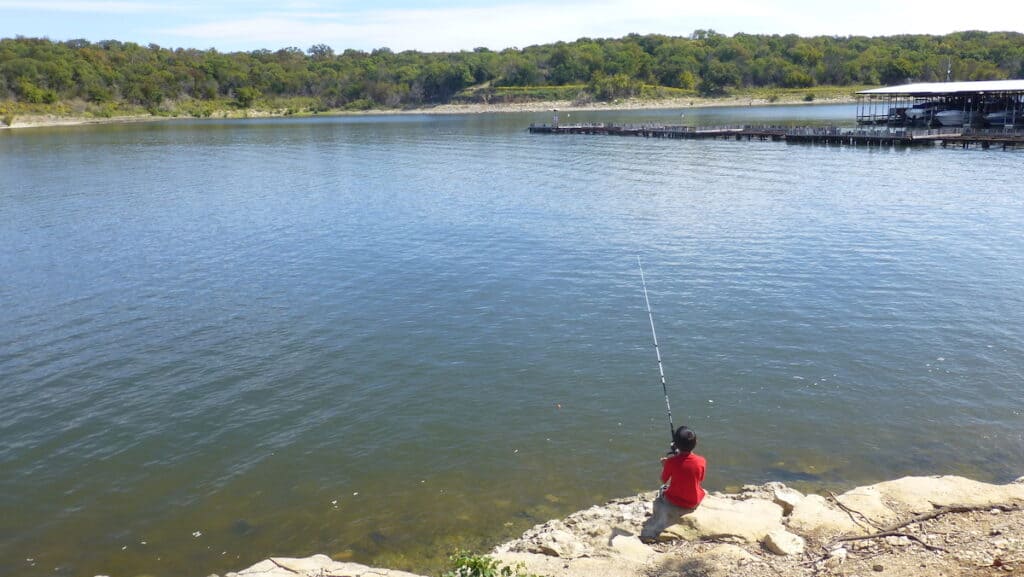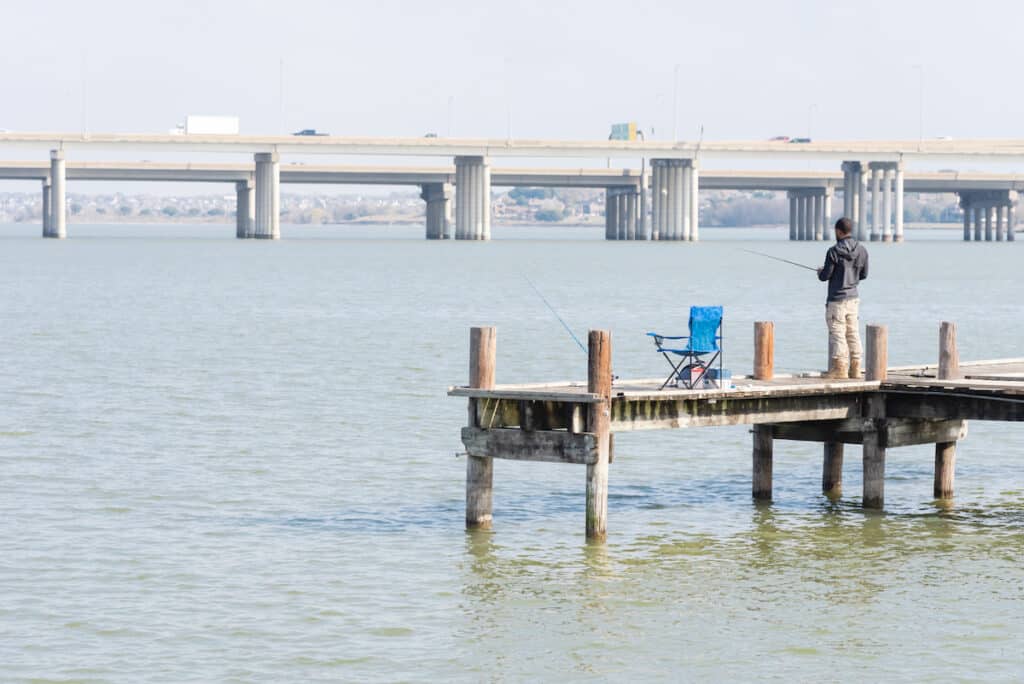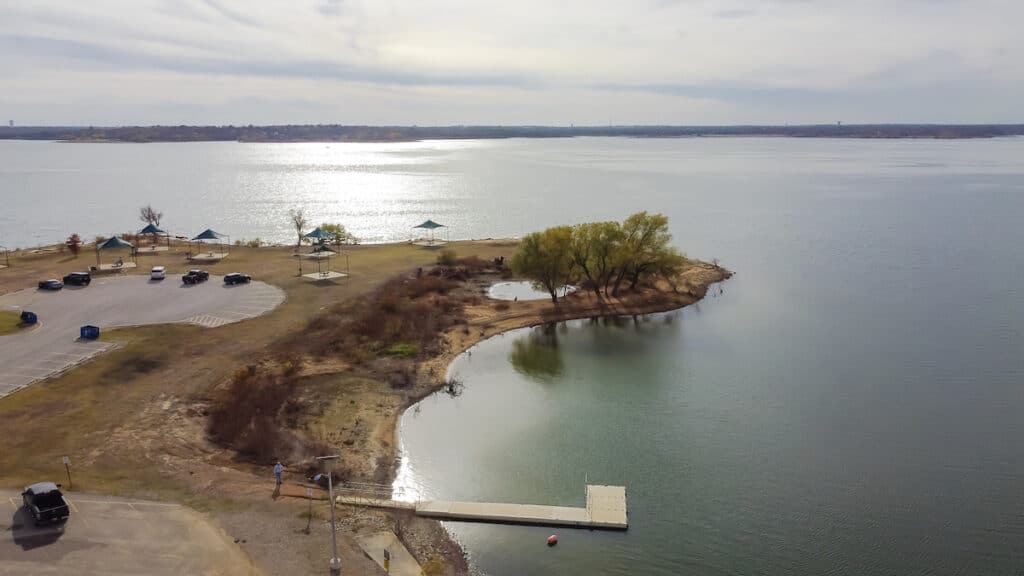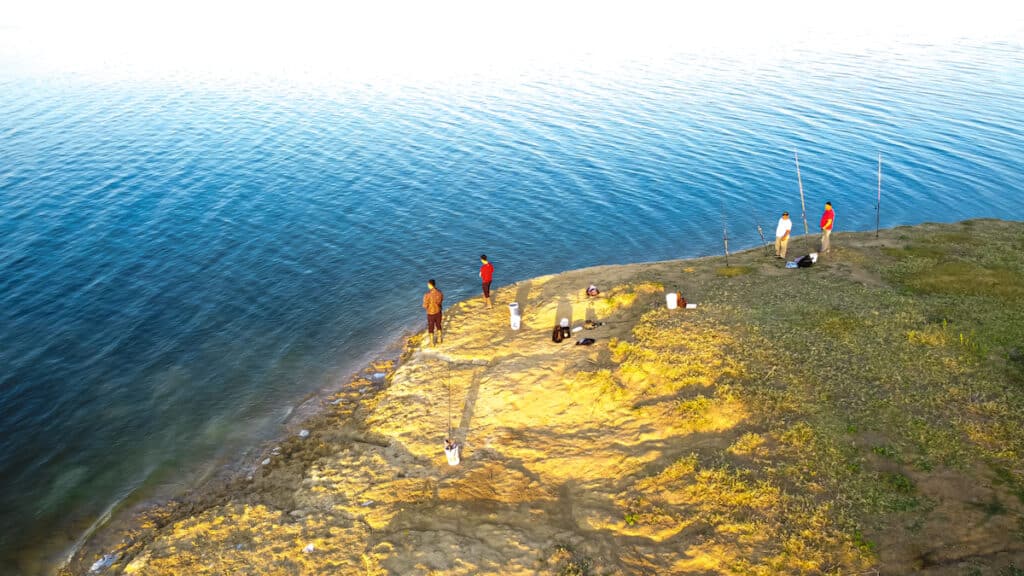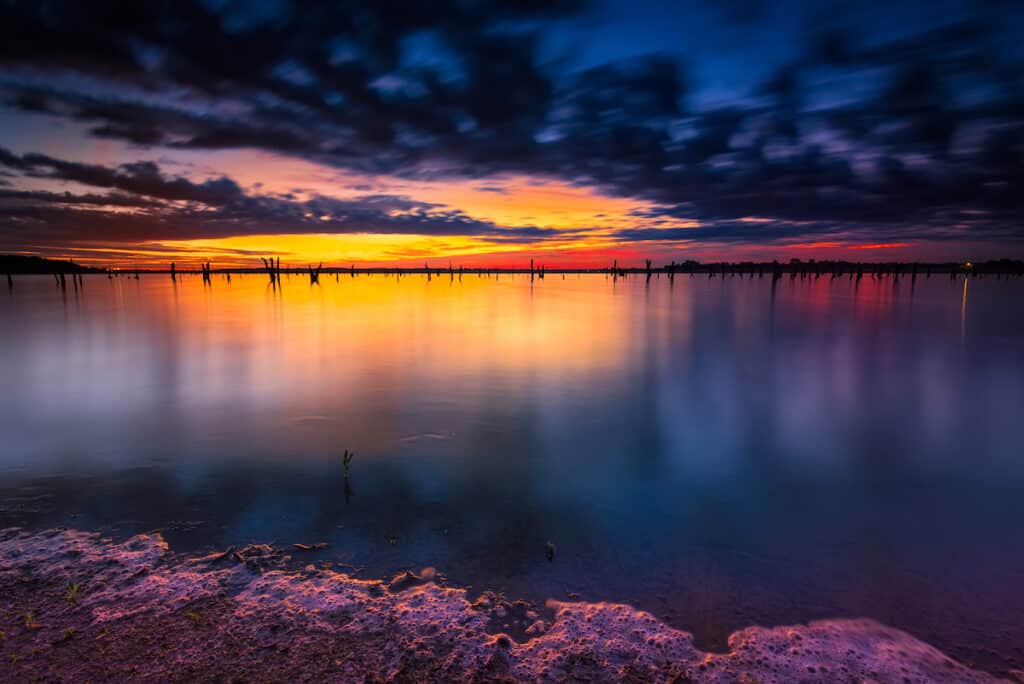The Dallas-Fort Worth area offers no shortage of great fishing options. Some of the best catfish lakes in North Texas are inside the city limits, and many more are within a two-hour drive of DFW.
Between heavy-hitters like Lake Texoma and Lake Tawakoni—both of which might just be in contention for best catfish lake in the state—are many other less well-known lakes that can just as easily send anglers home with a trophy blue catfish, a few monstrous flatheads, and a mess of channel cats for the table.
Catfish offer year-round fishing opportunities in the Lone Star State. If you’re looking for places to catch big cats in the Dallas-Fort Worth area, these 11 lakes should all be on your list.
Lake Tawakoni
The self-proclaimed “Catfish Capital of Texas,” Lake Tawakoni is a large reservoir spanning nearly 38,000 acres.
Honestly, at just under an hour east of Dallas, it’s not just a slogan that this is one of the most reliable catfish fishing factories in all of Texas.
Lake Tawakoni is fed by the Sabine River and Caddo Creek, and it’s fertile, moderately stained waters offer abundant forage and lots of great cover. Timber is scattered throughout the lake’s coves, as well as some stump fields, aquatic vegetation and shoreline brush.
Fishing for blue cats is reliably excellent from March through early June. Fresh cut bait is the most effective, but blue cats will go for live shad and other baitfish as well. If you can’t get your hands on live or cut bait, fresh shrimp are a decent substitute.
Strong numbers of catfish are caught in spring and summer, but the biggest blue cats often bite in winter. Catfish in the 50-pound-plus class are a real possibility.
Channel cats are even more abundant than blue catfish, and although they don’t get as massive, Lake Tawakoni is one of the most likely places in Texas to catch a channel cat over 10 pounds.
Tawakoni has a lot of excellent coves where channel cats congregate in spring, especially toward the upper end of the lake. In spring when the water is high, focus on flooded willows and brush along the shoreline in the backs of coves.
There are numerous places to fish from shore or launch a boat on this lake, but Lake Tawakoni State Park is a great place to start. There’s also a boat ramp just off Two Mile Bridge, and fishing around the bridge itself is often productive.
It may not have a slogan for striped bass, but Lake Tawakoni also is among the best striper fishing lakes in Texas.
Lake Texoma
If Lake Tawakoni is the catfish capital of Texas, then Lake Texoma is the jug line capital of texas.
Some of the biggest blue catfish in the world swim in this lake, and local anglers are known to hang hook, line and sinker beneath just about anything that will float.
Lake Texoma is a huge reservoir on the Red River, spanning over 74,000 acres on the Texas/Oklahoma border. The current Texas state record (and former world record) blue cat weighing 121.5 pounds was caught here in 2004.
Jug lining is a great way to put the odds in your favor. Locals often start their day by catching shad, and then set lines in creeks, coves and along the main river channel, particularly in the upper end of Lake Texoma.
Hook and line methods can be just as effective. Drift fishing over deep structure accounts for some of the biggest catfish in the lake. Focus on the edge of the river channel, and use a drift sock to slow your rate of drift.
Shad and cut perch are great baits for drift fishing. If fishing at night, try drifting in shallower creeks and coves near a drop to the main channel. A lot of blue cats and some huge flathead catfish are caught this way after dark.
The best shore fishing is spring and early summer. Channel catfish are abundant in near-shore areas, and flatheads nest in cavities right up against the bank once waters warm into the 70s.
A lot of channel catfish are caught using shad innards and smaller chunks of cut bait.
Lake Texoma has dozens of good public access sites. Juniper Point and Preston Bend are a couple of great spots operated by the U.S. Corps of Engineers toward the upper end of the lake.
More: Lake Texoma Fishing
Richland-Chambers Reservoir
41,000-acre Richland-Chambers Reservoir is located a little over an hour south of Dallas, and it’s a tremendous catfish lake that offers year-round fishing opportunities. Blue and channel catfish are both abundant.
The lake is made up of two main arms, fed by namesake Richland Creek and Chambers Creek. Both arms have a lot of great catfish habitat, including standing timber in the upper reaches.
A lot of catfish are caught in less than 10 feet of water during spring and early summer.
Cut bait, stink baits and punch baits are all effective. During the peak of the spring bite, it can often seem like catfish are everywhere and will bite on anything.
Trotline and jug line anglers also catch loads of catfish among the flooded timber and along creek bends, including some very hefty blue cats. True trophy-size fish are rare, but there are plenty of 20-pounders swimming in Richland-Chambers Reservoir.
The bite slows down from mid-summer to early fall. The best bet this time of year is to fish at night, and to bait likely spots in advance to get the fish active.
By late October, cats are usually moving again, and there’s a great bite through December in deeper timber in the 20- to 30-foot range. Try the Crab Creek area on the Richland Arm. Punch baits are favored by local anglers in late fall.
Several boat launch and shore fishing access sites are available on Richland-Chambers Reservoir. The Crab Creek Ramp on the Richland Arm and the FM 2859 Ramp on the Chambers Arm are good places to start.
Lake Fork
Lake Fork is a 27,000-acre Sabine River reservoir located about 90 minutes east of Dallas. It’s one of the best fishing lakes in Texas, but one in which catfish are often overlooked.
It almost goes without saying that Lake Fork is best known as one of the best big bass lakes anywhere in Texas. But it’s truly a multi-species fishery, and catfish are abundant. The fact that they don’t get nearly as much pressure as the bass do is great news for catfish anglers.
Channel catfish are abundant in Lake Fork, and it’s usually easy to catch a steady string of 2- to 4-pound cats. There’s also a decent flathead population, as well as some giant blue cats.
This is a lake where a 20-pound-plus fish can make off with your cut bait when you’re least expecting it.
Parts of Lake Fork are loaded with timber, and most local catfish anglers find success by targeting wood. While that stays fairly consistent, depth is the main variable.
As in many lakes, catfish in Lake Fork head shallow in April and May. But this is also an excellent summer catfish lake if you’re willing to target deep timber. Big summer cats bite at 25 to 35 feet—sometimes even deeper.
Try to get your bait as close as possible to the base of one of the submerged trees. It’s often a good tactic to start fairly shallow on a timber-covered point and work your way deeper until you start getting bites.
Punch baits are popular, and some local anglers chum with soured corn, wheat or milo to call the cats to dinner.
There are a few areas around the lake where cormorants roost in winter, and these areas tend to be especially attractive to catfish. W.C. Swearington Recreation Area is a good launch site that also offers bank fishing access.
More: Complete Guide to Fishing at Lake Fork
Lewisville Lake
An impoundment of the Elm Fork of the Trinity River that encompasses nearly 30,000 acres, Lewisville Lake is under an hour from both Dallas and Fort Worth. That makes it a popular fishing spot.
Lewisville Lake is, for the most part, a numbers lake. There are definitely some big blue cats over 20 pounds here, but you can expect to catch lots of channel catfish weighing 2 to 3 pounds, and decent numbers of blues in the 5- to 10-pound range.
The water at Lewisville Lake is usually stained, and there are several productive timber areas.
Look for catfish in 3 to 10 feet of water in April and May, and then work your way deeper as the water warms up. Chicken livers and cut shad are popular baits.
The best area for catfish is the northwest arm of the lake, which was once the entire lake until it was expanded in the 1950s. Prior to that time, Lewisville Lake was called Lake Dallas, and some people still refer to this arm as “Old Lake Dallas.”
This arm of Lewisville Lake is deep, and has excellent catfish structure. It’s separated from the rest of the lake by remnants of the original dam, which have been reshaped into a long earthen fishing pier. It’s arguably the best spot on the lake for bank fishing.
Water flows from Old Lake Dallas into the rest of Lake Lewisville through a narrow spot called “The Cut,” and currents in this area attract game fish of all kinds. Deep waters nearby often harbor some of the biggest catfish in the lake.
To launch on the Old Lake Dallas portion of Lewisville Lake, head to Westlake Park or the Crescent Oaks Boat Ramp.
Honorable Mentions
Plenty of lakes in and around the Dallas-Fort Worth Metroplex offer a chance to tangle with big cats.
While they may not quite be the best-of-the-best, these honorable mention lakes can also be great places to spend a day (or night) on the water.
Lake Ray Hubbard
Located right along the city limits of eastern Dallas, Lake Ray Hubbard offers some of the greatest urban fishing opportunities in the DFW area.
It’s definitely one of the best bets for big blue catfish close to home. They get fat here on abundant gizzard and threadfin shad.
A 21,600-acre reservoir on the East Fork of the Trinity River, Lake Ray Hubbard has the potential for 50-pound blue cats, and the biggest ones are usually caught in winter on deep structure.
Lake Ray Hubbard can basically be broken down into two sections: above the I-30 bridge, and below. The best catfish water is above the bridge, where there’s much more timber and other cover.
The bridge itself is also a good area to fish, especially in spring, when it’s possible to catch catfish in just a few feet of water using cut bait along the rip-rap. There’s also a warm water discharge toward the west side of the bridge that attracts fish in winter.
John Paul Jones Park is a good launch site on the west side of the lake near the bridge. Some catfish are also caught from shore at the park, though this lake is generally best fished from a boat.
Lake Ray Hubbard has multiple other nice fisheries, including being among the best white bass fishing spots in Texas when teamed with the Rowlett Creek tributary.
Grapevine Lake
Located just north of DFW International Airport, Grapevine Lake is an easy drive from just about anywhere in Dallas or Fort Worth, making it a very popular local fishery.
The lake spans 6,600 acres on Denton Creek, and offers mostly channel and blue catfish.
Blue catfish are actually the more common species in Grapevine Lake, and locals catch them via rod and reel as well as jug lining. Expect decent numbers of fish pushing 10 pounds, with an outside shot at a giant.
Despite its suburban surroundings, the shoreline of Grapevine Lake is mostly undeveloped. There’s also very little vegetation, and success here usually involves reading the bottom contours and identifying isolated patches of timber.
The best areas tend to be Twin Coves (near the midpoint of the north shore) and the upper end of the lake where Denton Creek empties into the reservoir.
Experienced local catfish anglers chum with cottonseed cake and catch fresh shad for bait using nets.
One great thing about Grapevine Lake is that its shoreline has an abundance of parks and launch sites. Try Trophy Club Park on the upper lake, or Twin Coves Park and Campground on Twin Coves.
Grapevine Lake has multiple fishing opportunities, including being one of the best smallmouth bass fishing lakes in Texas.
Lavon Lake
This 21,000-acre reservoir, commonly called Lake Lavon, is located just outside the city of Plano, east of Dallas. It’s a solid lake for blue catfish, and also has enough smaller channel cats to provide a good meal.
Lake Lavon is fed primarily by the East Fork of the Trinity River. It also has numerous tributaries that form smaller arms and coves, and are often packed with catfish in springtime. Pilot Grove Creek is an especially good one.
Blue catfish have a habit of spending their winters in the deep, lower end of the reservoir, migrating toward the upper end as the water warms up from spring into summer.
Channel catfish also move up into tributaries in spring, and some are caught along the rip-rap near the dam.
In summer, anglers should definitely watch the weather here. An influx of rain can cause the streams that feed Lavon Lake to swell, which sends an influx of nutrient-rich water into the lake and triggers catfish to feed in shallower water.
Lavon Lake doesn’t suffer from any shortage of access. It has more than 20 parks along the shoreline. Lavonia Park is a great spot near the dam that provides campsites as well as a boat ramp and bank fishing access.
Lavon has other fishing opportunities as well, including being on our list of the best crappie fishing lakes in Texas.
Lake Worth
Located entirely within the Fort Worth City Limits, Lake Worth is a 3,500-acre reservoir on the West Fork of the Trinity River. It’s an often-overlooked lake that offers what might be your best shot at a 50-pound blue cat in the city.
There are solid populations of channel and flathead catfish here too.
Lake Worth is fairly shallow, with stained water. The best catfish action is in spring, and there are some great shore fishing options.
That being said, the biggest blue cats are usually caught deep. The area around Wood Island, Goat Island and Mosque Point Park in the central part of the reservoir is productive.
Parts of the lake have an abundance of docks, boat houses and bulkheads (especially around the I-820 Bridge) and these areas can be great when catfish nest in burrows tight to the bank in late spring.
Boat launch facilities are available at Arrow S. Park, right off the eastern edge of the bridge. A fish consumption advisory is in effect on Lake Worth, so it might be best to approach this as a catch-and-release lake.
Ray Roberts Lake
The other “Ray” lake in DFW after Ray Hubbard, Ray Roberts Lake is a 25,600-acre reservoir near Denton. The main source of Ray Roberts Lake is the Elm Fork of the Trinity River, and it’s just upriver from Lewisville Lake.
Ray Roberts Lake has numerous creek arms in addition to the main river arm, all of which can produce catfish. Channel cats are most abundant, but the lake supports healthy flathead and blue cat populations as well.
This is generally more of a numbers lake than a trophy catfish lake. Look for catfish in spring and fall on any point or channel with timber.
It’s also worth noting that Ray Roberts lake has more than a dozen bridges, and some nice cats are caught around rip-rap and bridge pylons in spring.
A particularly productive area is the Isle du Bois Arm, above the Route 922 bridge. The Buck Creek Boat Ramp is a good place to launch nearby. Look for areas of timber in muddy water.
The shoreline of Lake Ray Roberts is almost entirely undeveloped, and is made up mostly of state park and public hunting lands. You have a lot of options for boat launching, shore fishing and camping.
Many anglers also know Lake Ray Roberts as one of the best bass fishing lakes near Dallas and Fort Worth.
Benbrook Lake
Benbrook Lake is a 3,600-acre reservoir on the Clear Fork of the Trinity River, located just 10 miles southwest of Downtown Fort Worth. It’s possible to catch a mixed bag of channel, blue and flathead catfish here.
As a general rule, the main lake is most productive during the cooler months, and the creek arms and backwaters are best from spring into early summer. That being said, main lake humps and ridges near the dam always have potential.
A lot of flathead catfish are also caught in and around the rip-rap on the face of the dam. Fishing here can be challenging due to the winds, but drifting live shad just above bottom can be highly effective. Use a drift sock to slow your drift.
For blues and channel cats, head to the uppermost end of the lake where the river feeds in. Cover is sparse throughout much of Benbrook Lake, but there are some isolated patches of timber.
Several launch sites are available around the lakeshore. Quality bank fishing is somewhat limited, but Holiday Park is probably your best bet to fish from shore.

